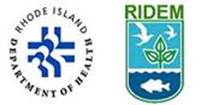
State Health and Environmental Officials Urge Prevention to Avoid Tick Bites
RIDOH launches new data dashboard for tick-borne diseases
With warmer weather now here, and with Rhode Island still a high-incidence state for Lyme disease, the Rhode Island Department of Health (RIDOH) and the Department of Environmental Management (DEM) are urging people to take precautions to prevent tick bites when outdoors.
After a mild winter in which more ticks than usual have likely survived into the spring, 2023 may be a bad year for tick bites and the transmission of Lyme disease and other tick-borne diseases.
“While Rhode Islanders are enjoying the great outdoors, we need to make sure we’re all taking these three key steps to preventing Lyme and other tick-borne diseases: Repel, Check, Remove,” said Interim Director of Health Utpala Bandy, MD, MPH. “Repel and reduce your exposure to ticks, check your body for ticks in the spots that they like to crawl and hide, and be sure to promptly and properly remove ticks if you find one on yourself, your family members, or your pets. Ticks are tiny and you may not be able to feel them or spot them right away. The sooner you find and remove them, the better your chances are at preventing the serious health issues caused by Lyme and other diseases ticks carry.”
Increasing numbers of ticks could be attributed to a variety of environmental factors that are symptomatic of climate change such as more moderate winters (allowing ticks that are alive in autumn to survive over the winter), hotter temperatures in the summer, and more rainfall.
“As the weather warms and Rhode Islanders begin returning to state parks, campgrounds, and management areas, so do ticks,” said DEM Director Terry Gray. “DEM and the RIDOH cooperate on a wide array of programs and initiatives to protect public health. Public education is critical. Again this year, DEM welcomes the chance to make RIDOH’s informative tick bite-prevention materials available for our park and campground visitors.”
As a part of this year’s tick prevention campaign, RIDOH has launched a new, interactive dashboard with data on several tick-borne disease, including Lyme disease, Anaplasmosis, Babesiosis, and Ehrlichiosis. The dashboard makes data available by case counts and case rates by year, sex, county, city, and town. The dashboard is available at https://health.ri.gov/data/tickborne
Rhode Island had 2,324 cases of Lyme disease in 2022. There were 980 cases of Lyme in Rhode Island in 2021. However, this significant increase is a result of a change in the case definition for Lyme. Historically, the national reporting standard for Lyme disease required healthcare providers to report specific clinical information on all potential cases of Lyme disease. In 2022, the national reporting standard changed. The national case definition for Lyme disease no longer requires the reporting of clinical information for cases in high-incidence states, such as Rhode Island. However, it counts laboratory tests only and that results in many more cases being included in the count. The next few years of surveillance will allow us to trend data using this new methodology.
RIDOH's ongoing Tick Free Rhode Island campaign highlights the three keys to tick safety: repel, check, and remove.
Repel
Keep ticks off you, your children, and pets by:
- Avoiding wooded and brushy areas with high grass and leaves. If you are going to be in a wooded area, walk in the center of the trail to avoid contact with overgrown grass, brush, and leaves at the edges of the trail. You can also spray your clothes with permethrin to keep ticks away. Make sure to not spray this on your skin.
- Wearing long pants and long-sleeve shirts when outside.
- Tucking your pants into your socks so ticks do not crawl under your clothes.
- Wearing light-colored clothing so you can see ticks more easily.
Check
Check yourself, your children, and pets, for ticks by:
- Taking a shower as soon as you come inside if you have been in grassy or wooded areas.
- Doing a full-body tick check using a mirror; parents should check their kids for ticks and pay special attention to the area in and around the ears, in the belly button, behind the knees, between the legs, around the waist, and in their hair.
- Checking your pets for ticks as well because they can bring ticks into the home.
Remove
Remove ticks from your body, as well as from children and pets, if you find them.
- Use a set of tweezers to remove the tick. Grasp the tick as close to the skin as possible and pull straight up.
- If you don't have tweezers, use your fingers with a tissue or rubber gloves.
Most people who get Lyme disease get a rash anywhere on their body, though it may not appear until long after the tick bite. (70-80% of people with Lyme disease will develop a rash, according to the Centers for Disease Control and Prevention.) At first, the rash looks like a red circle, but as the circle gets bigger, the middle changes color and seems to clear, so the rash looks like a target bull's-eye.
Some people don't get a rash but feel sick, with headaches, fever, body aches, and fatigue. Over time, they could have swelling and pain in their joints and a stiff, sore neck; or they could develop shooting pains, numbness, or tingling in the hands or feet, or facial drooping from nerve palsy. A few people may even experience heart problems. Lyme disease can be treated with antibiotics.
The Tick Free Rhode Island campaign features three animated Tick Free Rhode Island videos. The videos show how to repel both ticks and mosquitoes, how to check for ticks, and how to properly remove a tick from the skin. RIDOH's Rhode Island Tick Detective Workbook for Kids is also available online. To view the videos and get more information on Lyme disease and other tick-borne diseases, visit health.ri.gov/ticks.
